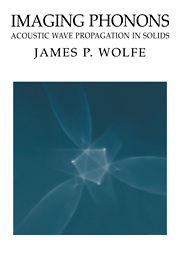Book contents
- Frontmatter
- Contents
- Preface
- Prologue – Anisotropic heat flow in crystals
- 1 Ballistic heat pulses and phonon imaging – A first look
- 2 Phonon focusing
- 3 Generation and detection of phonons – Experimental aspects
- 4 Focusing in cubic crystals
- 5 Acoustic symmetry and piezoelectricity
- 6 Lattice dynamics
- 7 Imaging of dispersive phonons
- 8 Phonon dynamics
- 9 Bulk scattering of phonons – Experiments
- 10 Quasidiffusion and the phonon source
- 11 Phonon scattering at interfaces
- 12 Refraction and reflection at solid/solid interfaces – Experiment
- 13 Imaging ultrasound in solids
- 14 Imaging surface acoustic waves
- 15 Interactions of ballistic phonons with electrons
- Appendix I Algebraic solution to the wave equation
- Appendix II Abbreviated tensor notation and group velocity
- Appendix III Survey of phonon focusing in cubic crystals
- Index
2 - Phonon focusing
Published online by Cambridge University Press: 24 March 2010
- Frontmatter
- Contents
- Preface
- Prologue – Anisotropic heat flow in crystals
- 1 Ballistic heat pulses and phonon imaging – A first look
- 2 Phonon focusing
- 3 Generation and detection of phonons – Experimental aspects
- 4 Focusing in cubic crystals
- 5 Acoustic symmetry and piezoelectricity
- 6 Lattice dynamics
- 7 Imaging of dispersive phonons
- 8 Phonon dynamics
- 9 Bulk scattering of phonons – Experiments
- 10 Quasidiffusion and the phonon source
- 11 Phonon scattering at interfaces
- 12 Refraction and reflection at solid/solid interfaces – Experiment
- 13 Imaging ultrasound in solids
- 14 Imaging surface acoustic waves
- 15 Interactions of ballistic phonons with electrons
- Appendix I Algebraic solution to the wave equation
- Appendix II Abbreviated tensor notation and group velocity
- Appendix III Survey of phonon focusing in cubic crystals
- Index
Summary
For a crystal containing N atoms, there are 3N normal modes of vibration. These normal modes are generally described in terms of plane waves of the form cos(k · r − ωt), where k is the wavevector with magnitude 2π/λ and ω ≡ 2πν is the angular frequency of the wave with wavelength λ and frequency ν. The boundary conditions of the crystal restrict the possible values of k, leading to a uniform grid of discrete wavevectors in k space, bounded by the Brillouin zone of the particular lattice. This quantization of wavevectors, k, is simply a result of classical mechanics.
Models of lattice dynamics seek to determine the vibrational frequency for a given k by considering the elastic forces between atoms. As an example, the dispersion relation, ω(k), for Ge along the axis is reproduced in Figure 1(a). The acoustic and optical branches are shown. Given this dispersion relation, the density of modes per unit frequency, D(ω), can be calculated. The density of modes – essentially a “vibrational spectrum” of the crystal – is basic to the thermal and electrical properties of the particular material.
Now quantum mechanics comes into play. If we think of a vibrational mode with wavevector k and (angular) frequency ω as a plane wave spread uniformly over the entire crystal, then, according to the quantum mechanics of the harmonic oscillator, the energy (and, hence, amplitude) of this wave can have only discrete values.
- Type
- Chapter
- Information
- Imaging PhononsAcoustic Wave Propagation in Solids, pp. 21 - 59Publisher: Cambridge University PressPrint publication year: 1998

